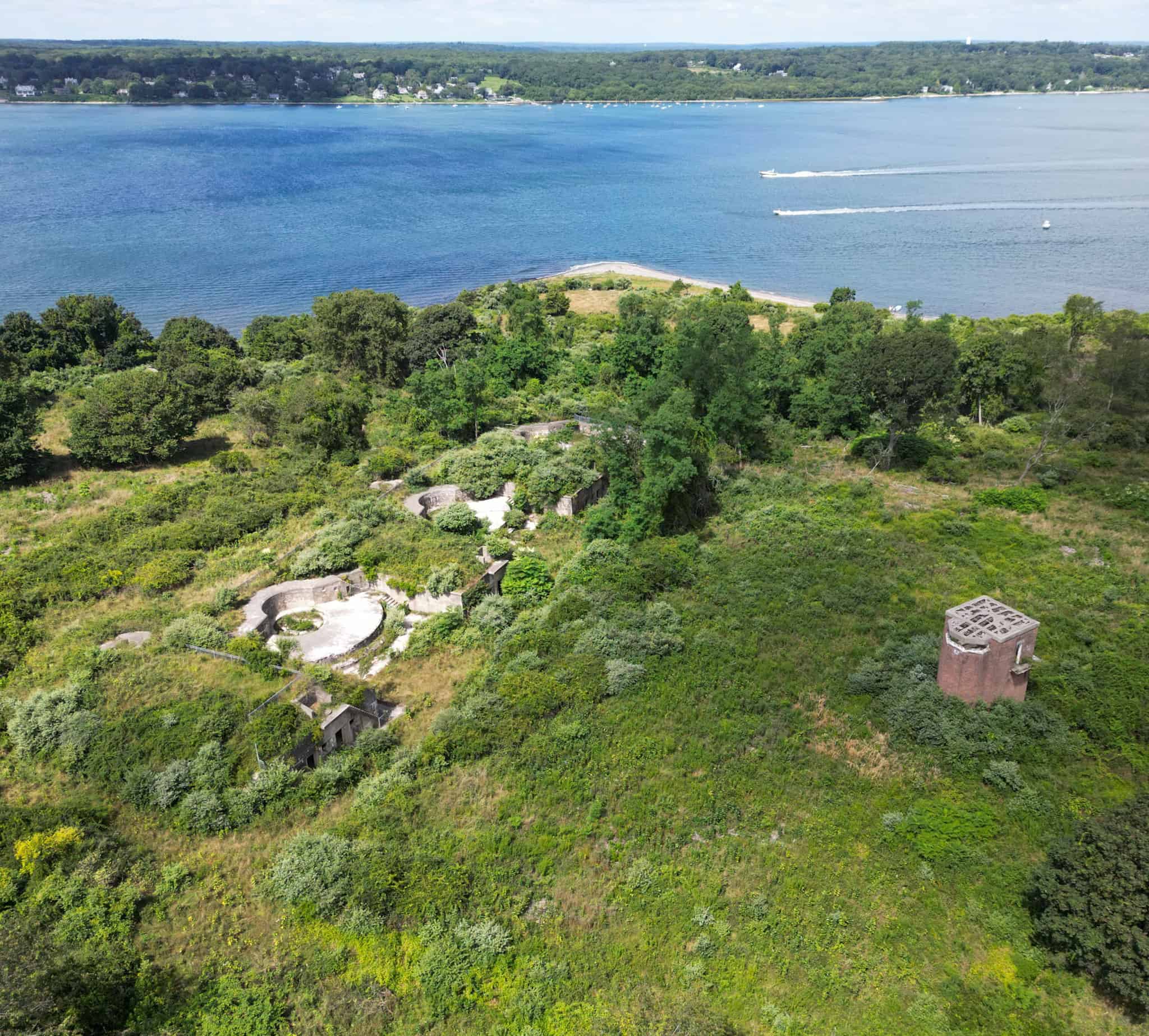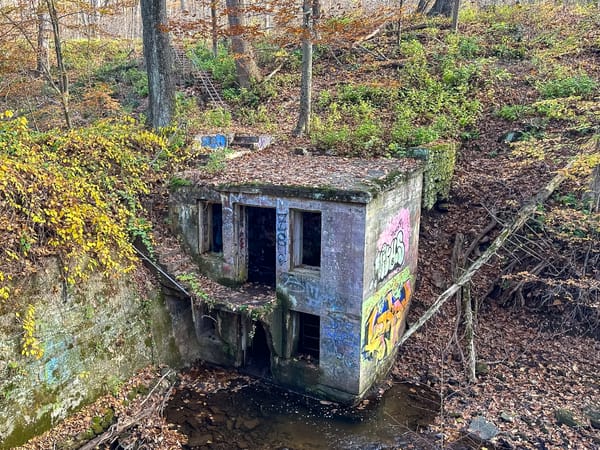Battery Mitchell (Dutch Island, RI)
On the remote shores of Dutch Island off Jamestown, Rhode Island, the long-abandoned Battery Mitchell stands as a haunting monument.

Tucked away on the remote and windswept shores of Dutch Island in Jamestown, Rhode Island, the long-abandoned Battery Mitchell stands as a haunting monument to America’s coastal defense past. Once part of Fort Greble, this reinforced-concrete battery helped guard the entrance to Narragansett Bay, serving as a vital link in the Harbor Defenses of Newport during the early 20th century.
Today, its crumbling walls and silent corridors offer a rare glimpse into the Endicott Period — an era when coastal fortifications were transformed by engineering innovation and strategic foresight.

The Birth of Battery Mitchell and the Endicott Era
By the late 1800s, dramatic advancements in artillery and naval technology had rendered traditional brick forts obsolete. In 1885, the U.S. government convened the Endicott Board, launching an ambitious program to modernize America’s harbor defenses with concrete gun batteries and disappearing-carriage artillery.
As part of this initiative, Fort Greble was established on Dutch Island, overseeing the approaches to both Newport Harbor and the Providence River. Construction of Battery Mitchell followed soon after, forming a key component of this defensive system.
The battery was named in honor of Captain David D. Mitchell, a U.S. Army officer who was killed in action during the Philippine-American War. His name joined a proud lineage of heroes memorialized in the coastal forts of the Endicott era.
Construction and Armament
Battery Mitchell was built in the early 1900s and equipped with three 6-inch M1903 guns, each mounted on M1903 disappearing carriages — a technological marvel of its time.
Manufactured at the Watervliet Arsenal and mounted on carriages produced by the Morgan Engineering Company, these guns could hurl shells weighing over 100 pounds across several miles of open water. When fired, the recoil system automatically lowered the gun behind a parapet wall, concealing it from enemy fire — hence the name “disappearing gun.”
The structure itself was typical of Endicott-era engineering:
- Two-story layout, with gun platforms above and ammunition magazines below
- Reinforced concrete walls and vaulted storage rooms
- Manual shell handling before the later introduction of electric hoists in larger batteries
From its commanding vantage point on Dutch Island, Battery Mitchell formed a crucial link in the layered defense network protecting Narragansett Bay.
World War I and Deactivation
The outbreak of World War I in 1914 marked a major shift in U.S. coastal defense priorities. As America entered the conflict, the military began transferring artillery pieces overseas to support the Allied war effort.
In 1917, all three guns from Battery Mitchell were dismounted and shipped to France, where they were adapted for use on field or railway carriages. After the war, the carriages were scrapped as part of post-war disarmament, and the battery was deactivated, never to be rearmed again.
What had once been a modern marvel of coastal defense was now an empty shell — a relic of a rapidly changing military world.
Battery Mitchell Today
Over a century later, Battery Mitchell still endures within the Dutch Island State Wildlife Management Area, a ghostly ruin slowly being reclaimed by nature. Its concrete chambers echo with the passage of time, while trees and brush creep over the once-orderly gun platforms.
Though its weapons are gone, the site’s sense of history remains palpable. The isolation of Dutch Island — accessible only by boat — has protected Battery Mitchell from vandalism and development, allowing its stark silhouette to remain remarkably intact.
Visitors who venture here can trace the outlines of gun mounts, explore darkened passageways, and imagine the soldiers who once stood watch over Narragansett Bay.
Visiting Battery Mitchell
Reaching Battery Mitchell requires preparation and a sense of adventure. The only way to access Dutch Island is by boat or kayak, most commonly launched from Fort Getty State Park in Jamestown. Once ashore, expect a challenging hike through dense vegetation and uneven terrain. The path is unmarked and requires careful navigation — long pants, insect repellent, and sturdy shoes are essential.
Visitor Information
- 📍 Address: Dutch Island, Jamestown, Rhode Island
- 🌐 GPS Coordinates: 41.503639, –71.401222
- 🚤 Access: By boat, kayak, or paddleboard from Fort Getty State Park
- ⛺ Terrain: Rough, overgrown, and unmaintained
- 🅿️ Parking: Available at Fort Getty State Park (entrance fee in summer months)
- ⚠️ Caution: The structure is deteriorating — explore at your own risk
For experienced explorers, the journey offers a rewarding chance to witness an untouched fragment of Rhode Island’s coastal defense history — one that few visitors ever see.
Why Battery Mitchell Matters
Battery Mitchell represents the ingenuity and ambition of the Endicott Period, when America’s engineers redefined coastal defense for the modern age. Its disappearing guns, concrete magazines, and strategic position on Dutch Island reflect a turning point in military architecture — one that bridged the gap between Civil War-era masonry forts and the high-tech radar installations of World War II.
Standing within its ruins today, surrounded by the wind and surf of Narragansett Bay, visitors can feel the deep connection between Rhode Island’s natural landscape and its military past. Battery Mitchell is more than an abandoned relic — it’s a living monument to innovation, sacrifice, and the passage of time.
Quick Facts
- 🏗 Constructed: Early 1900s (Endicott Period)
- ⚙️ Armament: Three 6-inch M1903 guns on M1903 disappearing carriages
- 💣 Guns Manufactured By: Watervliet Arsenal
- ⚡ Carriages By: Morgan Engineering Company
- 🕰 Guns Removed: 1917 (sent to France during WWI)
- 🏞 Now Part Of: Dutch Island State Wildlife Management Area
- ⚠️ Access: By boat only; overgrown and unmaintained
Final Thoughts
For those drawn to forgotten places and coastal history, Battery Mitchell offers a rare glimpse into a time when concrete and steel defended Rhode Island’s shores. Hidden amid Dutch Island’s wild terrain, it remains a powerful symbol of the Endicott Era’s bold vision — and a poignant reminder that even the mightiest fortifications eventually yield to time and tide.



